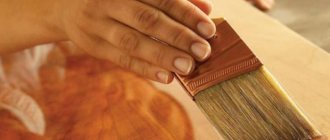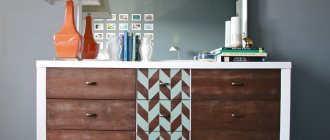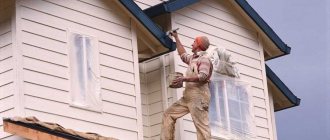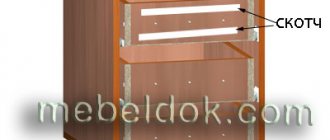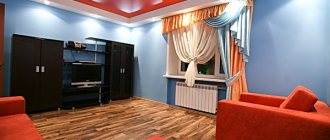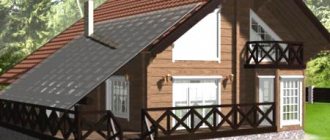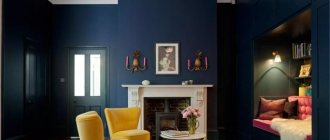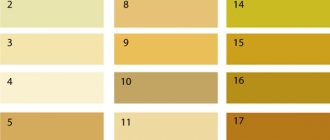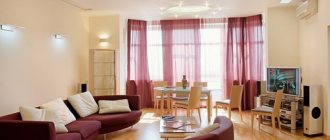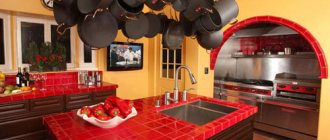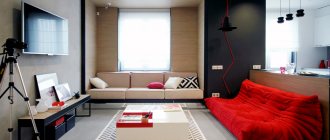Of primary importance when building a wooden house is the quality of the wood used. The choice of wood for building a house should be approached very carefully. Properly selected and applied in accordance with the manufacturer’s recommendations, facade paints, antiseptics, and wood glazes will effectively protect a wooden house from precipitation and UV, and keep it in excellent condition for many years.
Now it’s the 21st century and wood as a construction material is experiencing another surge in popularity. The craving for naturalness and natural materials is understandable. But it is not enough to build a wooden house or cottage, you need to provide them with proper care, and in order for the wood to last a long time and not lose its attractiveness, the house needs to be painted. When builders guarantee that a wooden building will last a hundred years, they mean its timely and correct protection from destruction.
Harmoniously selected color when painting a house
Why you need to protect a tree
Professional builders recommend painting a wooden house right away so that it lasts longer. Unprotected wood is negatively affected by almost all environmental factors. If a living tree is covered with bark, then only painting will protect the logs or boards.
- Exposed wood is destroyed by exposure to the sun's rays. Ultraviolet radiation affects lignin, a substance responsible for the lignification of plant cells. As a result, the wood darkens, becomes loose and damp. A fundamental change in the material occurs after six months of being in the open air. Since painting a wooden house over a damaged surface layer will not bring the desired result, you must first sand the surface to an undamaged material.
The logs of the log house dry out and crack over time.
Under the influence of ultraviolet radiation and temperature changes, the boards darkened and cracked
The cracked end of a log
- The alternation of rain and dry weather causes the wood to periodically swell and dry out unevenly. The result of the process is cracks of varying depths, which gradually increase. The house becomes unsightly and its ability to retain heat decreases. In addition, mold fungi settle in the cracks and rotting begins.
- Temperature changes in winter lead to moisture entering the pores of the wood during the thaw and then freezing. Ice crystals can tear wood fibers, forming cracks in the depths. Repeated repetition threatens that cracks will spread not only on the surface, but throughout the entire thickness of the frame.
Exterior painting of a wooden house creates a protective layer that serves as a barrier to negative influences.
What colors are in fashion now?
Currently, natural dark shades are becoming the most popular: brown, dark brown, and especially black or matte black . Despite the seemingly harshness of black, it gives the building nobility and elegance.
It is especially preferable to use black for painting wooden houses that have large white windows or glass verandas and doors. If you don’t like black, you can use equally popular brown or beige and shades closer to lighter tones.
Fashion changes much faster than façade painting, so don’t forget about personal preferences and inner feelings.
Types of paints
The abundance of modern paints and varnishes provides various options for solving the problem of how to paint the outside of a wooden house. All types of exterior or facade paint are divided into:
- glaze, i.e. translucent, preserving the appearance and texture of wood, having antiseptic properties;
- covering paints are oil, acrylic and alkyd paints that form an additional layer on top of the wood.
Types of paints and their differences in composition
Materials differ in composition, drying speed, appearance and other characteristics. Experts have not come to a clear conclusion about which paint is best to paint the outside of wooden houses, so you need to choose taking into account the wood from which the house is built (dry, damp, treated, old, etc.) and the climatic features of the area.
When choosing high-quality products, the preservation of wood is ensured for up to 15 years. Such a long-lasting and reliable effect can only be achieved by following the rules of painting and preliminary preparation.
Interior decoration of a wooden house
Your home is a reflection of yourself. The furnishings in a house can easily tell a lot about its owner: his style and lifestyle, his character. Through the interior you can embody your individuality. Interior design of a country house is a very difficult task, but at the same time very interesting and exciting. Thanks to the large area of the room, you can turn all your fantasies into reality, convey your vision of the world to others, and show your own view of things.
Before you begin to realize your dream of an exclusive and original interior in your country house, you need to clearly define for yourself what you want to get in the end, what sensations the future interior should convey. You need to take into account all the elements, including lighting, selection of furniture and decorative items, decide on the color scheme and style in which you would like to see your home.
An important role in creating a harmonious and cozy interior is played by the choice of stylistic direction. The style and interior decoration of a room often depends on the materials from which the house is built. For example, in houses built from profiled timber, owners often want to leave the appearance and texture of the wood. In this case, a Scandinavian-style interior may be suitable. This is a very natural and simple style. To play up the color of walls and ceilings, you can use various tinting and multi-colored azures to tone down the yellowness of the wood. The colors characteristic of this style are gray, greenish, bluish and beige.
The styles in which you can decorate a country house can be divided into two parts: the first is classical styles, such as Empire, Baroque, English style, Art Nouveau, Rococo, classicism, etc. And the second is the modern style, which includes such trends as pop art, techno, hi-tech, country, minimalism, constructivism and the like.
The classic interior is chosen by owners who want to emphasize their status, who are committed to eternal values and who pay tribute to traditions. The modern style is chosen by owners who prefer rationalism, choosing simplicity and functionality.
Each style corresponds to a specific color palette, for example, the classic style is characterized by noble shades: amber, terracotta, pastel yellow, cream, slightly greenish for painting walls and brown for floors and furniture.
To create a constructivist style, white is considered the main color, but you can also use red, blue or yellow, they will also be appropriate here. This style uses simple colors without shades or play of light.
Black and white are the color scheme for the minimalist style; here the play of halftones plays an important role. The combination of white and black creates the strongest contrast of light and dark. Also complementing this will be the natural color of wood, glass and brick.
Country is a rustic style. A house furnished in this style evokes a cozy and warm atmosphere. The style is characterized by combinations of different shades in one interior and dim, warm pastel colors. This style is ideal for houses built from rounded logs.
But we should not forget that the interior of a country house should not only be luxurious, stylish and original, but rather be cozy, comfortable to live in, and evoke positive emotions throughout your stay in it.
In any interior, first of all, the color scheme of the main surfaces is important, because the first thing that has the most tangible impact on a person is the color of the interior. Moreover, color affects both the psychological and physiological state of a person. Depending on the surrounding color scheme, a person can either remain in a cheerful mood for a long time, or quickly get a nervous breakdown. Color has a very big impact on a person’s well-being, but it is worth remembering that all people visually perceive this or that color differently. For example, bright colors can cause activity, excitement, and a surge of energy in one person, while in another they can cause irritation and aggression. Therefore, it is worth choosing colors that have a positive effect on you, because you are creating an interior for yourself and living in this house exactly for you.
Also, color can well hide a lot of flaws and at the same time emphasize the advantages of the room. The color can be warm or cool. Light colors visually expand the space, while dark colors, on the contrary, narrow it.
When choosing a color scheme for the interior, you should also take into account the functional significance of a particular room in the house, for example, the kitchen can be decorated in warm colors, such as orange, red or yellow, such colors increase appetite, but blue or green tones will create a feeling of freshness and promote visual expansion of your kitchen space.
The bedroom is intended for relaxation and sleep, so it is ideal to use light and warm colors to decorate it. The best colors here are white, beige, green, pink or blue. You should not use bright, saturated colors, because they can be unnerving and irritate the psyche.
It would be best to decorate the hallway in light colors, because it usually has a small area and is deprived of natural light; light walls will visually expand and make it lighter.
Light colors are best for the bathroom: white, light blue, light green, lilac, but this is provided that it is small in size. Bright, contrasting colors are suitable for a spacious bathroom, especially if it has good lighting. It is best to use calm shades for the office, because this is the territory of mental work. Light brown, beige, green or gray would be appropriate here.
But it would be best to decorate a child’s room in several different colors, taking into account the meaning of each functional area in the room. After all, on the one hand, we need bright colors that can encourage the child to play actively and develop, such as orange, red, purple, and on the other hand, we need calm colors that will soothe and encourage sleep, such as light green, beige, blue or pink.
Whatever color you choose for your country house, the main thing is that it contains love, comfort and the warmth of a family hearth.
Did you like the article? Tell your friends about it!
Wood pre-treatment
In order for the paint to apply smoothly, absorb well and last a long time, you need to prepare the surface for painting. Before treating the outside of a wooden house with any compound, antiseptic or fireproof, it is necessary to level the surface and seal the cracks.
After finishing the construction of the house, it is necessary to seal the joints and putty the cracks
The main condition is that the wood must be dry with a moisture level of no more than 20%, so preparation begins in the dry and warm season. If you put paint on a wet surface, the internal moisture will evaporate and destroy the coating and tear it away from the base.
The dry surface is cleaned of dust and dirt. If stains and stains of resin are difficult to remove, you can use a solvent. It is advisable to sand wood that was previously exposed to the open air mechanically.
After sanding, painting is carried out within 48 hours to ensure that the maximum effect of sanding is preserved.
First, the surface is treated with antiseptic primers or wood impregnations. Sometimes builders take on this work, but they often use the cheapest compounds - not very effective for preserving wood and environmentally unsafe. It is recommended to use water-based antiseptics that protect against the formation of mold, mildew and other biological formations on wood.
Antiseptics for wood
The application of antiseptics is carried out in strict accordance with the instructions indicated on the packaging. You cannot process at subzero temperatures, even if manufacturers offer winter antiseptics.
The better to paint
Paint for the facade of a wooden house can be translucent, glossy or matte. Since the natural look of wood is most attractive, glazing facade materials, which are available in the form of antiseptics, glazes or oils, are very popular.
The peculiarity of these materials is that they do not hide the structure of the wood. The materials work as impregnations, penetrate deep and create a barrier to getting wet or exposed to ultraviolet rays (UV). Despite their transparency, glaze paints are available in a wide range of colors. The most famous manufacturers:
- Renocoll (Rhenocoll) Germany.
- Teknos Finland.
If there is a desire to hide the surface of the wood, then use façade covering paints, which are divided into:
- oil - made from oils of natural origin and organic solvents;
- alkyd - produced in organic solvents or aqueous solutions of alkyds;
- acrylate (acrylic) coatings - based on acrylic and copolymers (latex, vinyl, silicone).
These paints form an opaque protective film that completely hides the wood grain. Over time, they oxidize, cease to be elastic and crack. Subsequently, the top layer turns into a powdery white substance (paint chalking process). After a few years, the layer will need to be removed completely or partially and the work done again.
Acrylic paints are more expensive and have a high degree of elasticity.
Well-known manufacturers of covering paints:
- Tikkurila (Finland).
- Alpina (Germany).
- Dufa (Germany).
- Beckers (Sweden).
- Dulux (Netherlands).
- Marshall (Türkiye).
Facade acrylic paint Dulux
Tikkurila paints are well known among us
Impregnation for the protection of wooden surfaces from Dufa
Among the Russian brands, the most popular are “Optimist”, “Svyatozar”, “Tex”, “Yaroslavskie Krasny”.
Average paint service life:
- glazing antiseptics – 5 years;
- acrylic – 8–10 years;
- oil – up to 6 years;
- alkyd materials – 7 years.
When comparing different types of paint, consider their pros and cons:
- oil paints – have a high penetrating ability, reliably protect against moisture, but dry slowly (several days depending on the temperature), which is sometimes unacceptable for outdoor work;
- alkyd compositions - have good frost resistance, but crack over time under the influence of UV;
- acrylic - convenient and easy to use, odorless, do not lose color, a new shade is easily obtained by mixing white paint with colorants (colored dyes), but if the house is painted with acrylic paint, then in the future you can only use them.
In recent years, acrylic paints and varnishes have taken a leading place, despite their higher price. Considering how much it costs to paint a wooden house and the effort it requires, it is not advisable to focus on cheap types. It’s better to do it well once than in 2-3 years the house will look sloppy. Immediately choose how to paint the outside of a private house or cottage for a long time , even if you have to invest more.
The total cost of painting depends mainly on the size of the house. This amount will include the cost of antiseptic, putty and paint.
Which color to choose
The choice of color depends only on the wishes of the homeowner. Manufacturers offer a wide range of shades. Typically, preferences depend on the design of the house and the location where it is located. To make the house visually blend with its environment, various shades of green, sand, and brown are chosen.
There are no restrictions on the choice of color, the main thing is aesthetics
To highlight a building in the area, you can use bright white, blue, and yellow. The most effective is the combination of two colors - light and dark.
A significant part of developers are more focused on the practical effect of painting, for example, dark colors attract rays, the surface heats up too much and cracks form on the wood. Light shades reflect light and do not fade longer, but dirt is more visible on them. The light gray color fades the least.
If resin appears on the wood, they prefer light dyes so that the wood does not heat up. Resin secretions are less noticeable against a background of cream, white, or ivory.
Often, paint is chosen to match or contrast with the color of the roofing material.
What color is best for painting the facade of a house?
The decorative design of a house largely depends on what shade the house is painted in. The most important thing when choosing a color is to be guided by the general style of the surrounding landscape, and personal preferences should be taken into account.
Choosing a paint that is not pleasing to the eye will be a big mistake, since an unpleasant shade will darken the mood and will not bring the proper aesthetic or inner comfort.
A home is not only a refuge, it is an area where a person should feel as comfortable as possible. When choosing paint, it is advisable to use shades that are closest to natural ones: brown, blue, gray, beige, white.
Flashy tones such as bright orange, scarlet, purple, light green contribute to the perception of the house as something toy, not real. Such houses will stand out beautifully against the backdrop of green vegetation, and certainly among nearby buildings. A bright façade is suitable for extravagant and emotional people for whom peace and solitude are not a suitable state.
When choosing a façade paint, it is important to consider the color match with the roof. The sample must be combined: either have a contrast, or be in the same color of a different shade. It is most appropriate to use the palette in such a way that the facade is lighter (for example, yellow) than the frames of windows, doors, and other prominent parts are darker.
Don't forget about the interior design of the house. It must match the external design: then there will be a feeling of complete consistency in style and individuality (more visual photos below).
Sequence of painting work
To properly paint a wooden house, you need to follow the technology and sequence of actions. Painting a frame house follows the same rules as a log house.
- First of all, the surface is cleaned of dust, construction debris, and resin stains - otherwise, mixed with the paint, foreign particles will remain on the facade. If this is not the first treatment of the building, then carefully remove the previous paint and clean the surface down to wood.
- Then mechanical grinding of the surface is carried out manually or using a grinding machine. Sanding and further painting are carried out with a short break, no more than 3 days, so that the cleaned base does not have time to suffer from external factors.
- In an old house, cracks, unevenness and damaged areas are puttied. If nails or other metal elements protrude from wood, they are coated with a special primer designed for metal.
- After this, the entire surface is covered with a primer with antiseptic properties and impregnations. The primer will not only perform protective functions - after its application, paint consumption will noticeably decrease and it will apply more evenly.
- Then they move directly to painting. The paint is applied with a roller or sprayed with a spray gun. It is necessary to take into account that acrylic facade paints and varnishes are too thick and viscous - only a professional tool is suitable for them. To use household sprayers, the paint will have to be thinned, which means the layer will be thinner than the manufacturers recommend.
- Painting is done in several layers. Each subsequent layer is applied only after the previous one has completely dried. When painting with a roller or brush, apply the paint along the grain of the wood.
How to choose a color, which color suits best
Having decided on the material and tone of the desired roof, you can begin to choose its specific color.
To avoid making serious mistakes, follow the rules:
- You should not choose the same color for the roof and facade. If you still decide to use the same color, then make the roof lighter or darker than the facade;
- Do not use brightly colored roofing against a dull building;
- Don't make your home too colorful;
- The combination of the color of the roof and the house must be in a certain balance, so use neutral shades along with bright shades;
- When making a contrast of bright and dark colors, remember that the bright shade should predominate.
